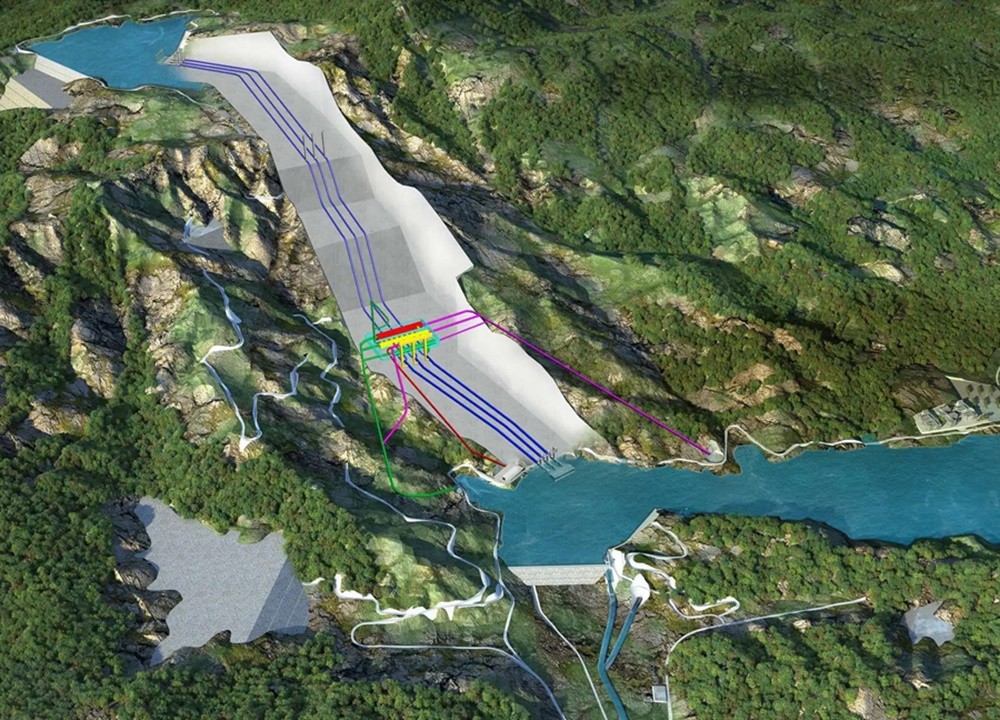Perception and Awareness of Practical Technology for GHG Emission Reduction in Power Generation of Vietnam
15:06 | 05/09/2023
COP stands for Conference of Parties held by the UN Climate Change every year since 1995. Since the remarkable COP 3, Kyoto Protocol in 1997, industrialized countries worked out several mechanisms to cope with global warming phenomena. In 2015, the Paris Climate Agreement at COP 21 was elaborated with a joint effort from developing countries to fight against climate change. Then UNFCC published several mechanisms including Nationally Determined Contributions (NDC), and the Internationally Transferred Mitigation Outcomes (ITMO). The Just Energy Transition Program (JETP) is also one of the initiatives to assist developing countries in every aspect of technologies and capacity building and to quickly adapt to the fast-changing adjustment of the international perspectives to mitigate Greenhouse Gas (GHG) emissions. Intergovernmental Panel on Climate Change (IPCC) with Article 6.2 created transactions of carbon offset and credit between countries. Those mechanisms can be grouped into the energy transition packages to cope with climate change and to reduce GHG emissions in particular. Why the energy sector is the focal point, and which technology could be effective and practical are not only to be addressed in this project, but also perception and awareness are to be analyzed in the effort to fight against climate change and balance the energy development of Viet Nam.
Various studies show the sources of GHG are from agriculture, buildings, industry, power, transport, waste management, and land use. GHG emissions are carbon dioxide, methane, nitrous oxide and F-gases. The main sources of GHG is from power and transport emitting the most carbon dioxide-CO2.
In developing countries, GHG main contributor comes from power production, which emits more than 40% of total GHG nationally. The public and society need to know that there are different emissions in power production that have been fully controlled except the CO2. It is important to clarify that the emission from power generation includes sulfur dioxide (SOx), nitrogen oxides (NOx), particle matter (PM) and CO2 … (Table 1). There have been strict standards and equipment required to control the SOx, NOx and PM from power plants. CO2, the main composition of GHG, was targeted by the UNFCC, IPCC and many other mechanisms worldwide.
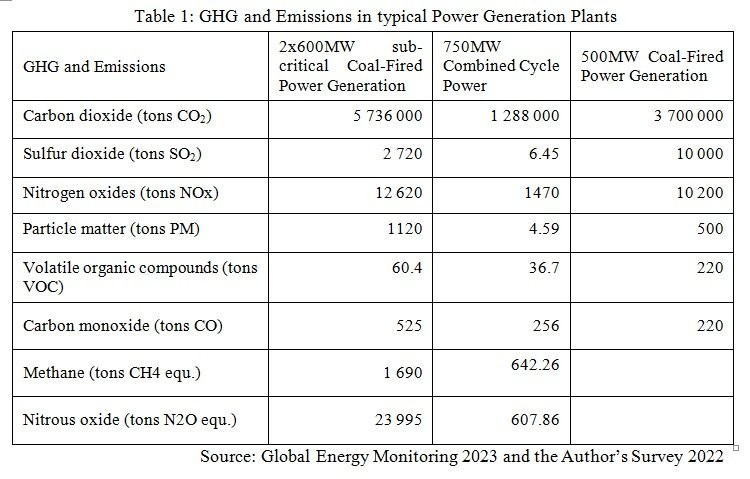 |
| Source: Global Energy Monitoring 2023 and the Author’s Survey 2022 |
There are not any possibilities that GHG will go down naturally or GHG will not make any changes to global warming. Then humans must take action to curb the global temperature which is the root cause of heat waves, and flooding that happens more frequently. Making more tightening emission standards, and increasing pollution taxes are important, but not enough. History shows that technology could change the course. Technology applications on electricity, the internet, and semiconductors… have made significant impacts on economic and social development. GHG technologies have been invested in R&D, significant results have been achieved by the big boost of renewable energy recently. These will be discussed for application in the power generation of Vietnam in the journey of energy transition.
GHG in Power Generation of Viet Nam
Like many countries, electric power production plays a vital role in the economic development of Viet Nam. By 2023, the total power generation of Viet Nam reached 80 GW, and the total capacity of the system is at the top of the ASEAN countries, of which, 21 GW is from renewable energy, 25 GW from coal-fired power plants with 71 units in 40 operating plants, 8 GW from combined cycle power with 15 units in operation, the rest is from hydropower and small scale sources. From the statistics, GHG from power generation of Viet Nam is 207.5 Mtone of CO2e accounting for 36.8% of total GHG emissions at 563.6 Mtone of CO2e in 2020 (ncif.gov.vn). In the business, as usual scenario (BAU) the total GHG emission could grow up to more than 1000 Mtone of CO2e in 2050 (McKinsey, 2022).
Figure 1: The pathway to NetZero by 2050 in Vietnam
Viet Nam has taken respective directions by making a commitment at COP 26 to fight against climate change and to implement an energy transition toward NetZero. A series of tasks and solutions have been put in the plan: rebuilding legal frameworks of de-carbonization and low-carbon development, attracting green investment; strategies, planning, and policies at the national and provincial levels to be adjusted to the commitment of NetZero.
Degree 55/NQ-TW of Politburo in February 2020 is the top directive for the energy development strategy of Viet Nam. It covers the first priority of energy security and points out the development of renewable energy from wind, and solar to biomass, waste-to-energy, energy efficiency and carbon capture projects. It is also requested to create a transparent, easy environment for businesses, breaking the barriers in procedure to encourage private-sector investment.
After COP 26, the Prime Minister of Vietnam made the Decision 888/QD-TTg on July 2022, There are 31 tasks assigned to Ministries and Provinces to be done before 2030 and 42 tasks in preparation for the target of 2050 NetZero. Also in July 2022, in Decision 896/QD-TTg, a specific target was set to limit the total GHG emission in 2030 is 43.5% reduction as compared to BAU, of which the energy sector has a 32.6% and not over 457 Mtone of CO2e. By 2050, Viet Nam should reach the NetZero target and the energy sector is to reduce 91.6% of GHG emissions and not over 101 Mton of CO2e. It is noted that the energy sector in Vietnam includes manufacturing, construction, transport, commerce, household services and power generation.
The National Energy Development Plan and Power Development Plan up to 2050 have been approved by the Prime Minister in 2023. It is the basics for the start of the green growth journey, to open opportunities to work with the international community on green investment, energy transition and green technology. Several technologies are on the table: carbon capture, utilization and storage (CCUS), fuel switch to green hydrogen or ammonia, renewable energy (RE) with wind and solar and emission trading are the practical solutions to be envisaged.
CCUS from the pilot to the demonstration projects
We have recognized that carbon dioxide is the major source of GHG in the air. Hence we should capture it, directly or indirectly. R&D of carbon capture and storage was promoted in the 1970s and the US and UK are the pioneers in capture, utilization and storage (CCUS) technology. By 2022, the US has spent $684 million USD to support CCS projects at six coal plants (the US Government Accountability Office, 2023). In early August 2023, the DOE/USA announced its grant of 1.2 billion USD to at least 13 Direct Air Capture projects. The outcome is expected to handle 1 million tons of CO2 every year.
UK government also confirmed unprecedented carbon capture investment of £20bn over 20 years (10 March 2023, gov. uk). The largest carbon capture and storage being deployed is the Viking CCS project located in the Humber, the UK's most industrialized region. Viking CCS is targeting its first CO2 storage as early as 2027 and a reduction of 10 million tons of UK emissions per annum by 2030 and up to 15 million tons by 2035. The project is led by Harbour Energy and is supported by the UK Climate Change Committee.
Several CCUS projects are being piloted, and tested in the world in Japan, Norway, Canada and the USA as seen in the table with some information on progress, capacity and funding from governments. In the EU (the North Sea) as well as in ASEAN more than 100 projects have been pushed forward to the feasibility study and FEED and are expected to reach the highest volume by 2030.
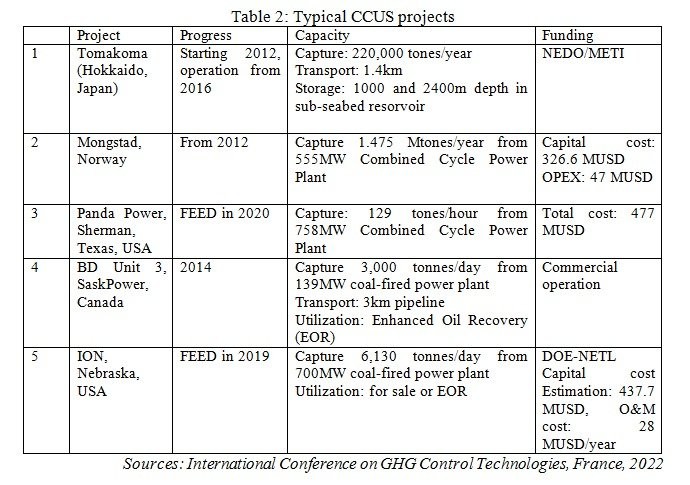 |
| Sources: International Conference on GHG Control Technologies, France, 2022 |
The success of those demonstrations and trials of CCUS technology is still quite limited so far. Only one project has been commercialized with about 1 million tons of CO2 a year, it is the SaskPower BD Unit3 in Canada. It is also reported many obstacles in operation and cost management. The process of CCUS technology is divided into the capture, transportation, utilization injection and storage of CO2. The lack of international standards for design, safety, construction and operation is one of many barriers. The storage of compressed CO2 in depleted reservoirs causes high expenditure right from the geological survey stage. If the volume of CO2 capture is small, industrial use is possible, but with a large volume, the well or reservoir needs to balance the cost of investment and operation.
R&D is working on the demonstration and trial CCUS projects and is expected to reduce the Capex and Opex in the near future. Developing countries with limited funding and no pilot project will depend on the proprietary patent of this technology. Companies that have acquired know-how and will eventually complete their supply chain are Aker Carbon Capture (Norway), Climeworks (Switzerland), Carbon Clean (UK), Carbfix (Iceland), Carbon Engineering (Canada)…
Of the technology of CCUS, the storage is the most challenging one. The storage system often takes the gas or oil field of the depleting reservoir, including the drilling rig with the existing air compression, monitoring system, and utilities. The existing pipeline or vessel transportation also are a big advantage. The injection system or the Enhanced Oil Recovery (EOR) needs to re-engineering. The financial break-even point for investment in the storage system is quite far from the starting point of the project even taking its storage as a project alone. We find out that in Viet Nam there are more than 10 existing facilities that can be transformed into CO2 storage with a capacity from 23 to 357 mill tons. The latest reports revealed 34 oil fields offshore of Viet Nam, with a total of 1.15 Gt of CO2 storage capacity in Cuu Long, Malay-Tho Chu, Nam Con Son, and Song Hong basins (Viet Nam Petroleum Institute, 2023). The Oil and Gas group company of Viet Nam had signed a joint-development with JOGMEC and JVPC (Japan) to test the CO2-EOR at Rang Dong in 15-2 Lot, Cuu Long basin. The test that happened in June 2011 showed an increase in the capacity of oil recovery from 950 barrels/day to 1.500 barrels/day.
Not only do oil-depleting reservoirs have the potential for CO2 storage but the coal mines in the northern countries and the gas field in Thai Binh province could be very promising once the scale of CO2 capture and transport make it cost-effective for storage system.
Fuel Switching needs matured technology
Instead of harvesting carbon dioxide from the stack, it is possible to separate it from the coal or gas, the fossil fuel, mix or replace it with green fuel (hydrogen or ammonia), this is called fuel switching. Such technology is Integrated Gasification Combined Cycle (IGCC), co-firing with green hydrogen and green ammonia. Phase-out coal is not simply to stop using coal as fuel but to maximize the co-firing rate or to apply gasification of coal to switch to green fuel.
The IGCC technology was promoted for more than 20 years. It is very likely with carbon capture technology, but CO2 is captured from the gasification process of coal or gas and go to the next step of CCUS: transport, utilization or storage. The total efficiency of plant to produce green electricity and capture CO2 are reportedly reduced by 5 to 10%. The non-stop operation of the gasification in IGCC makes it higher OPEX because of redundancy requirements.
A typical of IGCC is the Jazan IGCC complex recognized as the world’s largest IGCC complex. It is located in Jazan Economic City, southwest of Saudi Arabia, alongside the Jazan refinery. The project was commissioned in February 2020 with 5x770 MW combined cycle power plants, a gasification facility using vacuum residue from the adjacent refinery. The gasification unit will be supplied with oxygen generated by the air separation unit to produce hydrogen and syngas. The gasification unit is designed to deliver up to 2,110,000 Nm3/h of syngas which will be used for power generation.
Another IGCC success story has been the 250 MW Buggenum plant in The Netherlands. This coal-based IGCC plant currently uses about 30% biomass as a supplemental feedstock (GEM 2023). The obstacle of high cost and availability makes the IGCC technology slow progress. However, governments still give subsidies for feasibility studies and FEED to study the risk of implementation. A typical project is the ZeroGen 500MW IGCC project in Central Queensland, Australia.
In the search for green fuel, 04 types of hydrocarbon emerged: ammonia (NH3), hydrogen (H2), methane (CH4) and propane (C3H8). In fact, these have been well-known to people for a long time and have been used in industry. Ammonia for fertilizer and hydrogen has been produced and used as a cooling medium in power plants… But this time with large volume and to burn as a replacement to coal or gas.
Japan and Korea are the most interested in hydrogen and ammonia. Japan has a strategy to retrofit the coal fleet with ammonia co-firing from 2030 to 2050 with the rate increased from 20% to 50% and 100% ammonia. Companies supported by the government to develop the technology are IHI, MHI, JERA, Doosan, Kepco and Samsung (BloombergNEF, Japan’s Costly Ammonia Coal co-firing Strategy, September 2022). In many research projects, it has been tested the mix within 04 hydrocarbons, but ammonia was chosen because of the advantage of unit cost since other hydrocarbons were manufactured by ammonia-cracking. The co-firing technology is being tested for gas-fired and coal-fired power generation but they found that co-firing with ammonia caused low flame stability, high NOx and a mix rate is up to 20% (Advances in Ammonia Combustion Technology in Thermal Power Generation Systems for Carbon Emissions Reduction, Energies 2021).
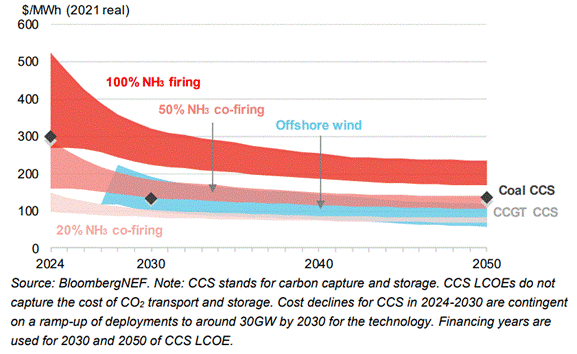 |
| Figure 2: LCOE of different technology and mix rate |
A recent report from BloombergNEF also revealed that the technology needs more time to be cost-effective, especially the 50% and 100% mix rate is important to scale up the deployment. As in Figure 2, it is shown that the Levelized Cost of Electricity (LCOE) of 50% co-firing is not even competitive with offshore wind energy by 2030.
Renewable Energy at scale
In the last 10 years, the world witnessed the ever-biggest expansion of solar and wind energy. Solar power has jumped ten times to 1053 GW all over the world, onshore wind power is more than two times to 835 GW and offshore wind power is 1085% to 63.2 GW. In 2022, solar energy (1323 TWh) contribute to 5% of total world electric power generation (28527 TWh). Wind energy with total capacity is less than solar but did contribute 7.5% of the total 2104 TWh.
Viet Nam also made incredible steps in solar energy development. She ranked 10th in the world because of the 18 GW addition within 10 years after the bigger developers like China, the US, Japan, and India…. With wind power from almost zero to more than 5GW in 2022, Vietnam also expanded quite rapidly to rank 17th in the world.
Among many sources of renewable energy, only solar and wind are having big potential. In recent years, many technical challenges integrated these power sources into the power system have been overcome. Some of the technical challenges were low inertia in frequency control, the increasing percentage of intermittence, substantial changes in generation mix between day and night… System operation and control have to adapt to the situation and in some moments of time, the whole system has been supplied by these green energy sources.
In the big fight against climate change, there are some considerations for further development of these green energy sources to scale. In Viet Nam, the equivalent time of maximum capacity for solar is 1550 hours, and for wind is 3150 hours, Compared with fossil fuel power plants, the equivalent time average is more than 6000 hours. If we need the same energy production from solar power, we need to build 4 times the capacity of fossil fuel energy and with wind power, we need two times the capacity. To develop the GW capacity of these green energy sources to replace the fleet of fossil fuel power plants, we must build at least double the existing sources. Then, only offshore wind farms could go for scale. The offshore wind project has the CapEx for 1 GW project at least US$2.5 billion and not less than 5 years of preparation to start construction (WBG, Vietnam Wind Power, December 2022). We believe with optimal supply chain structure and cheaper investment cost, the offshore wind is the best GHG technology selection.
The National Power Development Plan of Viet Nam for the period of 2021-2030 with consideration to 2050, usually called Master Plan 8 approved by the Prime Minister in May 2023 stated that: the development of solar power projects should reach 9 GW, rooftop solar to 8 GW, onshore wind to 22 GW and offshore is 6 GW in 2030. The government has a very clear strategy that reaching a potential of offshore wind power at scale in 2050 with an estimated capacity of 91.5 GW is the best solution to support and build the green economy.
Emission Trading System: International and domestic
The UNFCC has laid down a concept of carbon credit and carbon offset, 1 carbon credit or 1 carbon offset equals 1 ton of CO2 equivalent. This is the basics for accounting for carbon reduction and is very convenient for comparison between sectors, projects, areas, or countries. Countries will only need to put in place adequate monitoring, reporting, and verification (MRV) facilities, as well as arrangements for recording the corresponding adjustments in the national registry to avoid double counting of carbon credits. Once we have a commodity between many suppliers and absorbers, the market and pricing are inevitable. The carbon market is in two forms, the domestic and the international.
The Paris Agreement recognizes the role of international cooperation through carbon markets. It is stipulated that parties to the Paris Agreement can voluntarily cooperate in achieving Nationally Determined Contributions (NDCs) through “internationally transferred mitigation outcomes” (ITMOs), which is largely understood as international emission trading cooperation. International emission trading or ITMO requires international certification and verification. Then we saw international standards for carbon credit and offset such as CDM-CER, VERRA-VCS, Gold Standard, REDD+, IREC, and ACR…. Figure 3 shows in a day in 2023, there are 225 listings, almost 10 million USD of 3.35 million credits. Of which, Viet Nam has listed more than 100,000 credits, accounting for 3.12% of the total listed credits. The number is much less than that of India and China. Statistics show Viet Nam has been traded from the year 2000 with an accumulative 40,2 million CDM credits, mostly in renewable energy. This is likely linked to the attracting finance and technology for additional climate change actions.
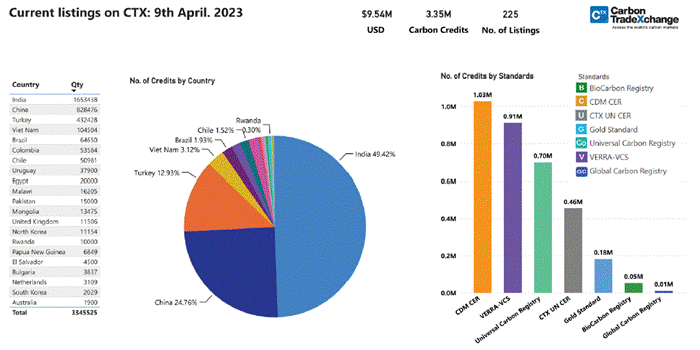 |
Figure 3: Trading of carbon credits on the CTX platform
If the domestic market is to open, the stock for international trading might bring about green investment, green bonds, or technological advancement and would expand the country’s participation in the international carbon market created under Article 6 of the Paris Agreement. The carbon market must be based on the data and verification, then statistics and analysis could give clues on which subsidies, tax rebates, concessionary finance, or risk guarantees to encourage renewable energy production, energy efficiency, or other investments that will allow emissions reductions and research, development, and deployment process by supporting new technologies. Information and education programs include raising awareness about emission impacts of decisions about mitigation opportunities and increasing the salience of price signals. Environmental certification or labeling programs, for example, help consumers make more informed decisions. The government’s provision of public goods and services includes funding research, strategic infrastructure, public transportation services, conservation of state-owned resources, or any other government action with the intent and result of reducing emissions would be better managed.
Many countries have launched the emission trading system (ETS). By 2023, there are 28 countries have opened the carbon market, and 21 at the stage of development and consideration. The ETS in Europe was working from 2005, New Zealand was from 2008, the US, Canada and Switzerland were from 2013, China officially inaugurated in 2021 after several years of pilots, in South East Asia: Indonesia, Thailand, Singapore and Vietnam are building their domestic emission trading markets. The ETS is expanding, the ETS is a powerful instrument to provide important incentives to invest in a green economy and encourage compliance with emission reduction targets (ICAP, 2023).
Perception and Awareness of GHG Technology
From the Kyoto Protocol (1997) to the Paris Agreement (2015), the world is hoping to bring people into a common effort to combat climate change. To share the responsibility, the government of Viet Nam has made a political commitment at COP 26 to NetZero by 2050.
In Decision 888/QD-TTg on 25/7/2022, necessary tasks have been placed to implement before 2030 and in preparation for the target of 2050 NetZero. The Prime Minister is also to make a decision approving the program to implement the JETP. In the set of required tasks, there is an imminent one, to establish the National Renewable Energy Center to promote technology transfer, knowledge sharing, capacity building and public consensus. Clearly defining tasks and solutions, establishing the National Renewable Energy Center, and JETP programs are only several of many measures that the government has taken to increase the perception and public awareness.
Practical technology for GHG mitigation probably causes the cost to rise more or less because of the de-carbonization of the energy supply. To elevate the perception of GHG technology, questionnaires and survey sheets will be introduced for experts to express their concerns. To more than 100 connected experts in the energy sector and more than 100 engineers from more than 10 power plants, the questionnaire and survey sheet of how to improve the perception and awareness of practical technology that can mitigate the GHG emissions in the power generation of Vietnam will be analyzed.
Discussion and consideration of the CCUS, fuel switching, RE, or ETS technology will be reviewed which could give analysis to the information management. There are also many solutions of green technology like tidal power, geothermal power, battery storage systems, biogas, and energy efficiency ... those are not to go to the scale of GWs will need a more thorough and insightful review in a separate study. The results and analysis of this project will be completed once the survey and questionnaire are implemented at the earliest time. This is expected to give more contributions to inspire the participation of business entities joining hands with the government and the international community to cope with climate change and to move forward to a green economy.
From the preliminary review and analysis, it is recognized that data and statistics of practical technology and market are essential to keep up with innovation and quickly adapt to the fast-changing adjustment of the international perspectives to mitigate GHG emission in order to increase the perception and public awareness in the effort to fight against climate change and balance the national energy development.
Prepared by: Van Xuan Anh (PhD in Energy and Power Systems)
References:
-
Nguyen Van Hieu , Nguyen Hoang Nam . Current GHG emissions situation of Viet Nam: Opportunities and Challenges. Viet Nam Journal of Hydrometeorology, August 2021.
-
Thang Nam Do, et al. Phasing out coal power in a developing country context: Insights from Vietnam. Elsevier, Energy Policy 176 (2023)
-
Trinh Nam Phong. Shaping the Carbon market in Viet Nam. Bulletin of Policy on Sustainable Development – Environment & Resource. ISSN 0866-7810, số 33, 2023.
-
Van Xuan Anh. An assessment of CDM project in the power sector under different approaches of setting baseline emissions: a case of Vietnam. International Association for Energy Economics and Australian Association for Energy Economics · Jun 7, 2000
-
Van Xuan Anh. Consultancy Report for the Management of Operation and Maintenance of a 600MW Coal-Fired Thermal Power Plant. R&D workshop at Vietnam Petroleum Institute · Jan 9, 2018
-
McKinsey’s Sustainability Practice. Charting a path for Vietnam to achieve its net-zero goals, October, 2022.
-
Allen & Overy Publication. Is Asia ready to embrace carbon capture and storage? November 2022
-
The State of Queensland. ZeroGen IGCC with CCS. A Case study, 2014.
-
Hookyung Lee, Recent Advances in Ammonia Combustion Technology in Thermal Power Generation System for Carbon Emissions Reduction, Energies 2021, 14, 5604.
-
Sylvera. Carbon Credits: Permission to Pollute, or Pivotal for Progress? 2023.
-
Andrew Steer. We must de-risk the energy transition for developing nations. Financial Times, May 2023
-
International Carbon Action Partnership (ICAP). Emission Trading in Practice: A Handbook on Design and Implementation, The World Bank 2021. Emissions Trading Worldwide, 2023

